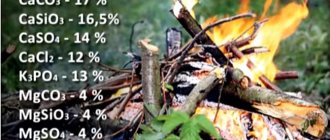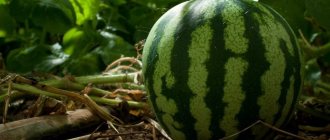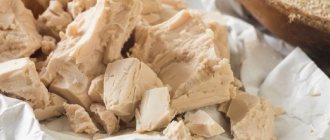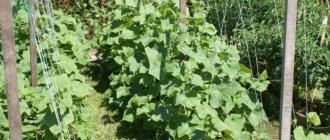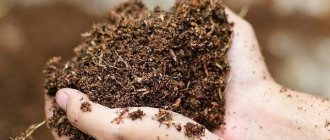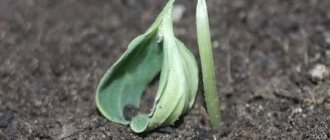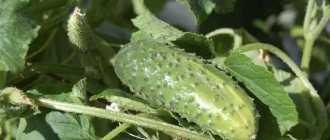Why feed cucumbers with ash?
Ash is a non-combustible combustion residue and a valuable organomineral fertilizer . It contains almost all the macro- and microelements needed by plants in an easily digestible form: phosphorus, potassium, calcium, iron, sulfur, silicon, manganese, magnesium, boron, molybdenum.
Depending on which plants are burned, the composition of wood slag will change:
- a substance obtained from deciduous trees and herbs (sunflower, buckwheat) contains a high concentration of potassium;
- Conifers, rye and wheat straw when burned produce ash rich in phosphorus.
Since ash contains the most phosphorus and potassium, it will be an excellent alternative to phosphorus and potassium fertilizers.
Phosphorus is necessary for cucumbers during the period of active formation of green mass and in the setting phase of future cucumbers.
Available potassium will increase the crop's resistance to pests and diseases , ensure rapid growth of a strong root system and vegetative mass, and help the moisture-loving cucumber regulate its water balance.
Attention! Do not feed cucumbers with ash formed after burning household waste (newspapers, magazines, boxes) with printing impregnations and dyes. Apart from the remains of pesticides, the plant will not receive anything.
Fertilizing cucumbers with this valuable fertilizer is necessary.:
- on acidic soils to neutralize acidity;
- during the period of flowering and formation of ovaries on cucumbers;
- during the autumn preparation of beds for cucumbers.
Pros and cons of this fertilizer
Advantages of using ash as a top dressing at your summer cottage:
- 100% natural composition;
- absence of chlorine;
- fast and affordable nutrition of the crop (thanks to the dust fraction, it quickly dissolves in water and mixes in the soil);
- improving the mechanical composition of the soil;
- alkalization of acidic soil;
- free raw materials;
- ease of preparation of basic fertilizer and solution.
Plant ash is one of the best environmentally friendly fertilizers for cucumbers and other crops . However, preparing fertilizer is not as simple as it seems at first glance.
Disadvantages of use:
- carbon monoxide acrid smoke produced when burning plant debris (when the fire is burning, stand only on the leeward side);
- harm to plants and humans if technology is not followed (mixing plant and household waste into one fire);
- Excessive application of fertilizer (more than 6-7 times per season) - with excessive application, the soil is oversaturated with salts, its porosity and air permeability are impaired, and the soil becomes unsuitable for growing cucumbers.
It can be useful:
Feeding tomatoes and cucumbers with whey
What kind of soil do cucumbers like and how to treat it correctly
Why do cucumber ovaries turn yellow and what to do about it?
The chemical composition of ash and the effect it has on the plant
Ash is an extremely useful organic fertilizer, extremely rich in various chemical elements.
It contains not only potassium and phosphorus, which are essential for garden plants, but also many microelements, only nitrogen and no chlorine, so this natural fertilizer can be used for any crop. It contains a lot of calcium, which is considered the main advantage of using ash powder to feed garden crops with this element.
The chemical composition of ash is not constant, it depends on the type of plants that were burned, as well as their age (there are more useful substances in the ashes of young plants than in the ashes of old ones), but on average it is in the following ratio:
- phosphorus – 16.5%;
- potassium – 17%;
- iron – 13%;
- zinc – 15%;
- boron, sulfur and manganese – 4%;
- calcium – 14%;
- magnesium – 12%;
- molybdenum – 0.5%.
Since there is an unequal amount of chemical elements in ash, it has different effects on plants and soil. For example, ash residue after burning birch branches or wheat straw can be used as phosphorus-potassium fertilizer, ash from burning sunflower stems or buckwheat tops can be used as potassium fertilizer. Ash powder can also be used to reduce soil acidity (what's left from burning coniferous trees or peat is suitable).
Ash for cucumbers is very useful, and above all, for increasing productivity. This is achieved due to the fact that after its use, plant leaves become larger and acquire a rich color, which leads to an increase in photosynthesis processes in them. After fertilizing cucumbers with ash, the number of flowers also increases, many ovaries appear, and the plants themselves become stronger, more resistant to diseases and pest attacks. It is also useful for calcium deficiency, which is manifested by weakness of cucumber roots, pallor of young cucumber leaves and shoot tips, bending of leaf blades down, falling of flowers and young ovaries.
When and how to feed cucumbers in the open ground with ash
Throughout the entire season, 4-6 feedings are enough for a cucumber.:
- phase of plant development, when 1-2 true leaves appear;
- at the stage of the first flowers blooming;
- at the beginning of fruiting;
- the next 2-3 feedings are applied throughout the entire fruiting period with an interval of 1 time in 14 days.
Dry application
Dry ash is used to cultivate a future site for planting cucumbers . When digging the beds before sowing, add 100 g (1 cup) of the substance per 1 m². In heavy soil, ash is added for digging in the fall and spring, and in light sandy loam - only in the spring (due to the rapid leaching of nutrients).
When sowing seeds (or planting seedlings), a groove 10-15 cm deep is made along the planned cucumber plantings, into which dry ash is poured and immediately covered with earth.
Important! Never mix ash with mineral fertilizers (superphosphate, urea, etc.). When they are mixed, alkaline compounds are formed, nitrogen is lost, and phosphorus is converted into a hard-to-reach form.
Pest protection
Ash is an effective means of fighting parasites.
Attention!
Pests can be destroyed if you treat the leaves of the plant from the back side as well.
Thanks to it you can get rid of:
- fleas and cabbage flies. To do this, you need to sprinkle the shoots with dry ash mixed with crushed tobacco;
- caterpillars;
- aphids. For this purpose, vegetable growers prepare a solution from ash, soap (100 g each), water (12 liters) and urea (2 tbsp). Leave the solution for 48-72 hours, then treat it against aphids;
- ants;
- slugs.
All destruction work must be carried out in the evening. To obtain the best effect, repeat the procedure 2 or 3 times every other day.
How to prepare the solution
Cucumbers need liquid ash fertilizers during their active flowering and fruiting . To prepare the solution, take 100-150 sifted ash and dissolve it in a bucket of water. Watering rate: 0.5 liters of solution per adult plant.
Attention! To water with ash, use warm water. After watering with cold water, cucumbers may develop fungal diseases due to hypothermia of the roots.
How to prepare fertilizer for future use
It happens that too much ash is produced (for example, when burning branches left after autumn pruning of an orchard). It won’t be used for the remaining season, and it’s irrational to throw away good raw materials. To harvest for future use, you will need a dry room (outbuilding, barn, greenhouse dressing room) and storage containers (boxes, thick plastic bags).
Ash is only afraid of dampness . It does not lose its valuable properties over time and, if stored correctly, will last for more than one season.
What kind of ash can be used for feeding?
When we talk about ash, we mean the non-combustible residue after burning various plants and trees. If you need to obtain ash with a high potassium content, then you need to use deciduous trees and grass. Phosphorus-enriched ash remains after burning conifers and wheat.
Cucumbers also respond gratefully to the ash that is obtained by burning birch bark and various other plants. The main thing is that it does not contain any admixtures of household waste, which contains substances hazardous to the health of the plantings.
How to fertilize correctly
1 glass of ash powder is dissolved in a bucket of water and allowed to brew for 5-7 days . This amount of solution is enough for 2 m2 of area (0.5 liters of liquid fertilizer is consumed per plant). The frequency of feeding is 1 time every 14 days.
In liquid form
Ash is used as a means to combat pests, diseases and as foliar feeding. For foliar feeding, it is recommended to combine ash with urea. These two fertilizers can be mixed, one component will complement the other. The dosages of substances when preparing a solution for spraying will vary in different months:
- in the first half of the season (May - early July) - 12 g of urea and 250 g of wood ash are diluted in a bucket of water;
- from mid-July to the end of fruiting - 5 g of urea and 250 g of ash.
If you decide to grow cucumbers completely without “chemicals”, use a folk recipe:
Pour boiling water over 300 g of sifted ash and leave for 25-30 minutes. The resulting infusion is brought to a working solution with 10 liters of water.
Reference! To avoid burning the plants, follow the dosage of preparing the solution; spray only in cloudy weather.
Frequency of use
Ash can be added to the soil only before planting seedlings in a permanent place of growth. During the growing season, gardeners can spray the plants 2-3 times if there are problems with growth, or the cucumbers are attacked by insects and fungi. Ash is used as root feeding throughout the season according to the schedules given above. High-quality treatment of plants with ash is a complete replacement for chemical fertilizers.
Features of using ash fertilizer for cucumbers in a greenhouse
In a greenhouse, the soil should be completely changed every 3-5 years . Fertilizing cucumbers with ash in a greenhouse is no different from fertilizing cucumbers in open ground. The only peculiarity is that in a greenhouse, cucumbers go through all phases of development faster, so the frequency of watering at the root can be reduced to 3-4 times.
When foliar spraying of plants, it is useful to treat the walls of the greenhouse . Protected soil is a breeding ground for fungi, but they are afraid of ash. Irrigation in greenhouses is carried out in the morning so that the cucumber leaves remain dry at night.
Is it possible to sprinkle ashes on cucumbers?
Novice gardeners doubt whether it is worth fertilizing cucumbers with ash. This issue has long been resolved, and reviews from experienced vegetable growers prove the effectiveness of ash fertilizing. If it is prepared according to all the rules and used according to the instructions, then the roots form better, and the foliage, shoots and fruits develop well.
Owners of garden plots use ashes as protection against snails and slugs. The use of ash fertilizer is allowed for cucumbers growing in a greenhouse, open ground or at home.
If you treat cucumbers with ashes, the vegetable will receive the necessary elements. At the same time, vegetable growers will notice:
- accelerated photosynthesis, which has a beneficial effect on the development of culture;
- strengthening roots. Fertilizing cucumbers with ash will lead to this result, which improves the structure of the soil, saturating it with oxygen;
- cucumber lashes have become more durable;
- accelerated plant growth;
- cucumber leaves become larger and more saturated in color;
- increased resistance to negative environmental factors;
- reducing the likelihood of diseases;
- increased productivity.
It is necessary to feed cucumbers with ash, as it is beneficial for the crop. These properties prove that gardeners will benefit from using this fertilizer.
Despite the obvious benefits of the substance, there are still contraindications to its use:
- It is prohibited to use ash obtained as a result of burning garbage or materials with synthetic impurities;
- acidic and calcareous lands;
- cannot be used until at least two true leaves appear on the cucumber seedlings;
- You cannot sprinkle it with ash and use a solution based on it to water the fruits of the plant, because they will become unsuitable for consumption.
If you follow these recommendations, then the likelihood of harming the crop is low.
Advice from experienced summer residents
In order for fertilizing cucumbers with ash to benefit them, follow the recommendations for preparing fertilizer and the advice of summer residents who successfully use ash solutions on their site:
- Use the ash to soak cucumber seeds. Soaking seeds for 4-5 hours will give future plants protection from pests and diseases and additional nutrition. To prepare ash infusion, mix 20 g of ash and 1 glass of water. The infusion can be used 24 hours after preparation.
- For cucumbers, it is important to frequently add ash in minimal doses. The peculiarity of this crop is the gradual absorption of fertilizing a little at a time.
- During the period of fruit filling, reduce mineral supplements. It is often recommended to mix ash with nitrogen and potassium fertilizers, but cucumber is a watery vegetable. Everything that the plant absorbs at the time of fruit growth will be in the cucumber harvest.
- It is necessary to add dry ash before watering so that all its beneficial elements immediately reach the roots.
Signs of potassium and calcium deficiency
If seedlings are deficient in these components, they begin to wither. If this happens, then additional feeding is needed.
Signs of potassium deficiency:
- a yellow or light green edging appears on the sheet;
- the leaves become wrinkled, dark, and often dry out;
- the shape of the foliage changes, its edges turn inward;
- the stems wither prematurely.
Symptoms of calcium deficiency:
- leaves turn white;
- the tops of the lashes become pale;
- rapid withering, death of leaves.
Feeding cucumbers with ash, which is added in the required quantities, helps to revive the crop and promotes its development.
Reviews
Gardeners actively use ash as a fertilizer and speak positively about the results of fertilizing . The main thing is to first find out whether it is possible to fertilize the beds on your site with ash and find out what the soil composition is there.
Nadezhda, Moscow region : “Ash is simply a universal thing. I'm retired now and I can't afford many fertilizers. And it immediately replaces a whole set of means for me: as a fertilizer, as a means of protection against pests and diseases, as a soil deoxidizer.”
Alexander, Lipetsk region : “The property of ash to deoxidize the soil is not useful for everyone. At my dacha the soil is alkaline and cucumbers grow just fine. If you add it, you can upset the acid balance.”
Maya, Tver : “When cucumbers sprout and form 3 leaves, I always make watering holes around the plants. I water the cucumbers in them, and when they bloom, I add ash mash every 10 days. I’m not complaining about the harvest.”
Errors in using ash fertilizer
If fertilizing cucumbers with ash is done incorrectly, the result will be the opposite of what was expected. For example:
- the plants will begin to get sick;
- the yield of cucumbers will be reduced;
- the cucumber vine may die.
This happens because gardeners apply ash fertilizers incorrectly. Errors:
- Simultaneous application of ashes, fresh manure and other organic matter. As a result, the soil becomes depleted because it loses nitrogen in large quantities.
- Mixing fertilizers with mineral fertilizers containing phosphorus. In this case, the plants do not absorb the element, and it settles in the soil.
- Treatment of alkaline soil. Ash can change the acidity of the soil and make it unfertile.
- You should not frequently use such fertilizer on the same area.
The duration of the ash is 3 years. Therefore, it is important to follow the dosage.
Feeding cucumbers with onion peels
Onion peel fertilizer is good because it can be used for both root and foliar feeding. At the same time, spraying and watering cucumbers with an infusion of onion peels is not only a complete feeding, but also protection against diseases.
This infusion is prepared from 1 tightly filled glass of husk and 8 liters of very hot water. The mixture should be infused for 2-3 days, after which it should be strained. This feeding is useful not only for cucumbers, but also for many other vegetable crops, in particular tomatoes.
The use of ash against diseases and pests
To get your favorite vegetable of good quality and attractive appearance, the gardener needs to monitor the health of the bushes. Ash components are considered a good means of preventing diseases and garden pests. For this purpose, the properties of ash lye are used to kill microbes and repel various parasites. To get the right drug you need:
- Sift the ash in the amount of 2/3 of the bucket, and then fill it with water (10 l).
- Provide access to sunlight to the resulting solution. Keep the mixture in the sun for 4-5 days, constantly stirring the solution.
- After yellow oily stains appear on the surface, collect them in a separate container and then mix with water in a 1 to 1 ratio.
- Add pieces of laundry soap to the resulting preparation. This will improve the stickiness of the resulting product and will reduce the amount of the drug used per bush.
The resulting product is applied to the bushes at night. Then after 3-4 days the procedure is repeated.
If a greenhouse or greenhouse is used for growing vegetables, then various pests may appear that breed in indoor areas. To destroy fleas or flies, use dry ash flour, which is carefully sifted. Then the powder is poured into a gauze bag. They shake it over the bushes where the insects have appeared. You may not like this method because of the stickiness of the ash components to clothing and exposed parts of the body, but for plants this method of killing parasites is quite acceptable. It is necessary to ensure that the powder covers all the outer parts of the plants with an even layer.
Note. Slugs gnaw off young shoots and roots of plants, and ash waste prevents them from getting to food. To repel slugs, ash flour is scattered around the roots of plants. To do this, make holes around each bush, pour dry ash into it, and moisten it a little with water. You can sprinkle dry powder on the bottom of the plants. This will reduce the parasite's ability to damage the bushes.
The validity period of wood ash waste is from 1 to 3 years. After this, you need to add new portions of fertilizer. But using the same beds for constant sowing of the same type of vegetables is not recommended, since yields will constantly fall.
Feeding with ash at different stages of cucumber growth: table
In the table we will show you the optimal combination of ash and water for preparing a nutrient solution used at different stages of cucumber development
| Cucumber development stage | Ash quantity | Water volume, liters |
| Pre-soaking seeds | 1 tbsp. | 2 |
| The appearance of two full leaves | 10 tbsp. | 5 |
| Beginning of flowering | 10 tbsp. | 5 |
| Fruiting | 3 glasses | 3 |
| Preventing diseases and pests | 3 kg | 10 |
Table of the content of mineral elements in the ash of various trees
The ash waste of various trees contains the following amounts of microelements necessary for plants:
| woody plant | Content of chemical elements | |||||||
| Ca | TO | Fe | Mn | Sr | Zn | Cu | Cr | |
| Pine | 1110.8 | 273 | 52.4 | 4 | — | 5.5 | 1.138 | 0.618 |
| Spruce | 1398.5 | 245 | 10 | 9.58 | 12.4 | 7.71 | 1.263 | 1.191 |
| Fir | 1268.9 | 1000.9 | 16 | 16.86 | 6.75 | 6.02 | 1.05 | 2.028 |
| Larch | 844.4 | 162.1 | 5 | 23 | 13.24 | 3.31 | 2.004 | 0.7 |
| Oak | 928.7 | 737.3 | 13.4 | 7.8 | 3.86 | 1.19 | 2.081 | 0.957 |
| Elm | 2281.2 | 2729.3 | 18.2 | 4.01 | 9.05 | 4.12 | 1.119 | 1.463 |
| Linden | 1859.9 | 791.6 | 12 | 9 | 8.15 | 2.38 | 1.643 | 1.463 |
| Birch | 1631.8 | 540 | 17 | 23.61 | 4.21 | 20.02 | 1.82 | 1.25 |
| Aspen | 2100.7 | 781.4 | 12.4 | 5.71 | 9.19 | 12.89 | 1.737 | 1.576 |
| Poplar | 4758.3 | 1802 | 18 | 8.2 | 17.28 | 15.15 | 1.311 | 1.82 |
| Black alder | 1201.6 | 589.6 | 130.1 | 15.2 | 4.12 | 5.08 | 2.535 | 1.657 |
| Gray alder | 1620.5 | 631.3 | 31.6 | 5.7 | 6.1 | 9.32 | 2.009 | 1.277 |
| Bird cherry | 1868 | 554.6 | 8.2 | 4.46 | 11.39 | 4.57 | 1.509 | 1.37 |
Carbonate and polycarbonate, orthophosphate and potassium silicate - 16%; In addition to the indicated microelements, ash waste contains the following chemical compounds:
- calcium sulfate −14%;
- calcium chloride −12%;
- sulfate, silicate and magnesium carbonate - less than 5%.
Iodine in ash waste is contained in microdoses, which have virtually no effect on the development of vegetables.
Preparing fertilizer for future use
It often happens that there is too much ash, and it will not be possible to use all of it in a season. Do not rush to throw away such a valuable product; if stored properly, it will not lose its beneficial properties. The remaining ash must be placed in a thick plastic bag and tied properly.
You can take any container or box. The main thing is to close it tightly and place the container with fertilizer in a dry place, for example, in a barn or pantry. The only thing that can spoil the ash is moisture.
Answers to frequently asked questions
Does it make sense to treat cucumber seeds with an ash solution?
Yes, keeping seeds in an infusion speeds up their germination and has a beneficial effect on the further development of the plant.
How to protect plants from night temperature changes?
Cucumbers do not tolerate cold weather well. When cold nights are forecast, it is advisable to cover the bed with covering material. Mulching the root zone can also help.
Is it necessary to break off the leaves of cucumbers?
Large leaf plates prevent the penetration of light; it is better to remove excess ones.
Is it possible to add a lot of ash?
Ash alkalizes the soil. The optimal pH for cucumbers is 5 – 7. Excessive application can provoke the transition of a number of chemical elements into an inaccessible form.
Is it possible to apply ash in parallel with other fertilizers?
It is not recommended to apply organic and mineral fertilizers at the same time. It's better to do this one by one. When applying complex fertilizers, it is better to avoid ash.
Common mistakes
Feeding cucumbers with ash is not a difficult task and does not require any special skills from gardeners. But even despite this, some gardeners often make typical mistakes when working with this fertilizer. Remember that you absolutely cannot do several things:
- Burn household waste along with wood. It is unacceptable for household waste to get into the fire with future ash, since their combustion products will be dangerous for plants and can lead either to the death of the plantings or to the appearance of nitrates in the fruits.
- Add ash to the soil immediately after adding lime. Such manipulations will reduce the taste of the crop.
- Use manure and ashes at the same time. The substances in their composition neutralize each other’s actions, so there will definitely be no benefit from such a fertilizer.
- Violate the dosage during the preparation of fertilizing. Many gardeners are convinced that the more ash you put in, the better the plant will be. But this is not so; an excess of microelements can even lead to the death of plantings.
- Fertilize the soil with a mixture of ash and complex mineral fertilizers. The ash already contains useful microelements, which are sufficient for plants. You only need to use one thing.
- Feed fertile soil with ash. It is difficult to make good soil even better without upsetting the balance. But it’s easy to spoil it. Therefore, if your land is still fertile, then it will be quite enough to carry out no more than two feedings per season.
How to use fertilizer
Many summer residents are interested in how to properly dilute and apply fertilizers from ash. To feed cucumbers, two methods of using wood ash are used: dry fertilizer and liquid fertilizer.
If we talk about dry feeding, then it is best to use fresh burned material. It can be sprinkled between the bushes and then watered generously. There will be nothing wrong if fertilizer gets on the leaves. When planting seedlings, it is advisable to first distribute the fertilizer on the ground, and then plant the bushes. The consumption rate is fifty grams of ash per square meter. After adding the ash, you can lightly sprinkle it with earth.
Wet feeding indicates that a special infusion is being prepared from the ash. You need to take a bucket of warm water and dilute 200 grams of ash in it. Let it sit for about a week. Then water under each bush. The fertilizer is perfectly absorbed into the soil, penetrating to the roots, providing the necessary nutrition. Basically, this fertilizer is applied to open ground.
Fertilizers are used at different periods of the life phase of plants: during flowering, when the ovary appears, during fruit ripening. Sometimes, even before planting, you can sprinkle ash on the soil. But it is worth remembering that during the period of adaptation, that is, getting used to a new place, you should not feed the bushes. This is another stress for them.
You should not use fertilizers too often or too much. Everything should be in moderation. Three or four times a summer will be enough. Fertilizing will be more successful in warm weather, after good watering. Do not apply ash together with chemical nitrogen-containing fertilizers. Plant poisoning may occur.
It is important to know that its use differs from one plant to another. For example, burning wood will produce fertilizer rich in calcium, while the resulting mixture of low shrubs or grasses contains a lot of potassium. Correct application will enrich the soil for a long time.
What to do if the cucumbers are overfed?
In general, it is quite difficult to overfeed with ash. To do this, you literally need to add it in bags. So if signs of illness appear, you need to look for the cause in something else. For example, in poor soil or lack of other microelements.
If you are absolutely sure that the problem is ash, then you need to stop feeding, water the cucumbers with clean water without impurities and loosen the soil. If the bushes have not returned to normal within a few days, you can carefully spray them with a weak solution of ammonia.

